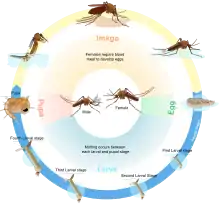Aedes africanus
Aedes africanus is a species of mosquito that is found on the continent of Africa with the exclusion of Madagascar.[1] Aedes aegypti and Aedes africanus are the two main yellow fever vector species in Zambia.[2] Aedes africanus is mainly found in tropical forests not near wetlands.[3]
| Aedes africanus | |
|---|---|
| Scientific classification | |
| Kingdom: | Animalia |
| Phylum: | Arthropoda |
| Class: | Insecta |
| Order: | Diptera |
| Family: | Culicidae |
| Genus: | Aedes |
| Species: | A. africanus |
| Binomial name | |
| Aedes africanus (Theobald, 1901) | |
| Synonyms | |
|
Stegomyia africanus | |
Identification
This mosquito has distinct white and black stripes along its body which help differentiate the genus from others in this family.[4] Females of this species are ectoparasites and can most often be found on mammals living in the tropical forests of Africa.[4] The africanus species can be distinguished from other mosquitoes in the genus Aedes by having white scales on the maxillary palpi, scutum with a patch of large white scales, and 3 large white patches on the mid-femur.[4]
Life cycle

This species lays its eggs in holes in trees, cut bamboo, bamboo stumps, and tree forks.[4][5] In laboratory settings, it was observed that the larvae hatch best at 27 °C and the quantity of water was not a factor in embryonic development but we most often laid within 2 cm of the water surface.[3]
Aedes africanus adults are crepuscular feeders, meaning they feed from dusk to dawn.[6] Although this species is a vector for many diseases, because it is mainly found in forests, primates are its main source of blood meals.[6] Early studies of its populations suggest that when sampled in forested areas, it made up 95% of the caught species and only 50% in surrounding villages.[7] When populations are high enough, Toxorhynchites mosquitoes can be brought in as a biological control as they parasitize africanus larvae in the shared breeding habitat.[8]
Medical importance

This species of mosquito is an essential yellow fever vector in wooded habitats.[3] In addition to being a major vector of yellow fever, Aedes africanus also vectors pathogens such as dengue virus, West Nile virus, and Rift Valley fever virus.[1][9] It is also a vector of Zika virus, the causal agent of Zika fever.[10]
References
- Walter Reed Biosystematics Unit, Systematic Catalog of Culicidae, "Systematic Catalog of Culicidae". Archived from the original on 2015-11-29. Retrieved 2015-12-02.
- Masaninga, F.; Muleba, M.; Masendu, H.; Songolo, P.; Mweene-Ndumba, I.; Mazaba-Liwewe, M.; Kamuliwo, M.; Ameneshewa, B.; Siziya, S.; Babaniyi, O. (2014). "Distribution of yellow fever vectors in the Northwestern and Western provinces, Zambia". Asian Pacific Journal of Tropical Medicine. 7 (1): S88–S92. doi:10.1016/s1995-7645(14)60210-8.
- Sempala, S (1981). "Some laboratory observations on the biology of Aedes (Stegomyia) africanus". Insect science and its application. 2 (3): 189–195. doi:10.1017/s1742758400001004.
- Huang, Y (1990). "The subgenus Stegomyia of Aedes in the Afrotropical region. I. The africanus group of species (Diptera: Culicidae)". Contributions of the American Entomological Institute. 26 (1): 3–90.
- Schaeffer, B.; Mondet, B.; Touzeau, S. (2008). "Using a climate-dependent model to predict mosquito abundance: Application to Aedes (Stegomyia) africanus and Aedes (Diceromyia) furcifer (Diptera: Culicidae)". Genetics and Evolution. 8 (4): 422–432. doi:10.1016/j.meegid.2007.07.002.
- Ross, R.; Gillett, J. (1950). "The cyclical transmission of yellow fever virus through the Grivet monkey, Cercopithecus aethiops centralis Neumann, and the Mosquito Aedes (Stegomyia) africanus Theobald". Annals of Tropical Medicine and Parasitology. 44 (4): 351. doi:10.1080/00034983.1950.11685460.
- Bang, Y.; Brown, D.; Arata, A. (1980). "Ecological studies on Aedes africanus (Diptera: Culicidae) and associated species in southeastern Nigeria". Journal of Medical Entomology. 17 (5): 411–416. doi:10.1093/jmedent/17.5.411.
- Sempala, S (1982). "Interactions between immature Aedes africanus (Theobald) and larvae of two predatory species of Toxorhynchites (Diptera: Culicidae) in Zika Forest, Uganda". Bulletin of Entomological Research. 73 (1): 19–24. doi:10.1017/s0007485300013754.
- http://www.ianphi.org/whatwedo/projects/uganda5.html
- Hayes, Edward B. (2009). "Zika Virus Outside Africa". Emerging Infectious Diseases. 15 (9): 1347–1350. doi:10.3201/eid1509.090442. PMC 2819875. PMID 19788800.